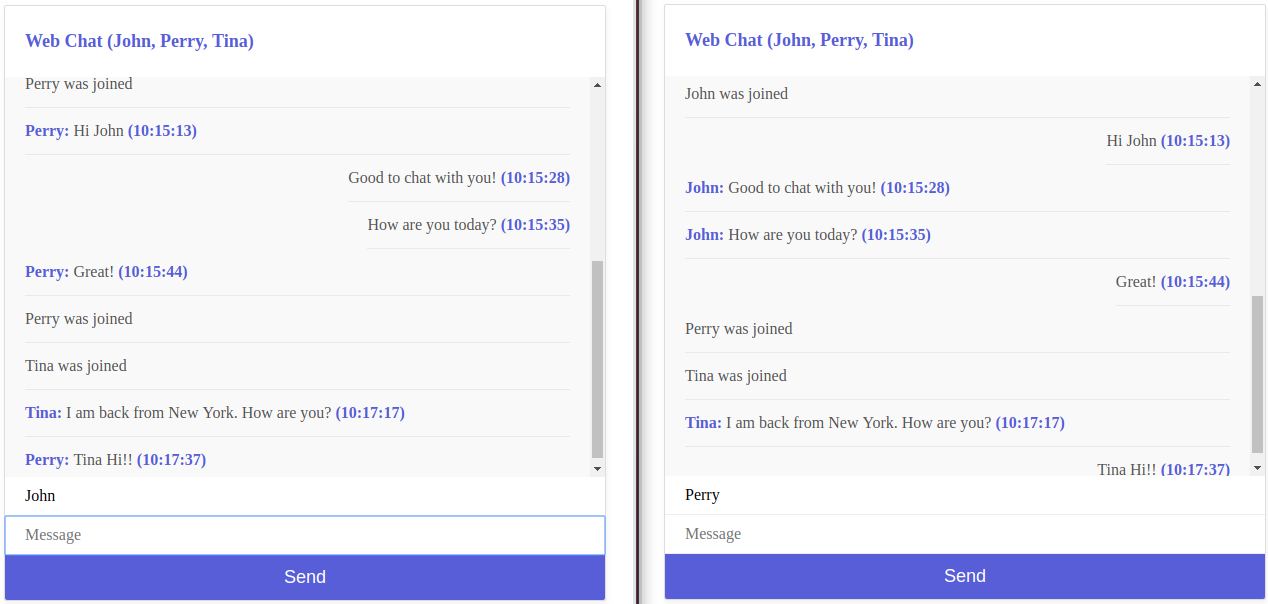

It shows a chat application in which socket.io is used to connect server and client. Also, It supports 1-to-1 and groupchat using channel based communication. In this project, PUBSUB structure was deployed to support Say, Join and Leave.
The server has a strangth to support massive traffics where the number of members is huge in a chatroom. It is different with mobile text application since delivery and display notifications are not required since all members basically show a chatroom together as well as Slack.
$ go get github.com/nkovacs/go-socket.io
$ go run main.goDocker Build
$ docker build -t webchat-golang:v1 .-
socket.io provide stable connection between server and client
-
Participant lists are listed on the top
-
User name is updated automatically without duplication
type Event struct {
EvtType string
User string
Timestamp int
Text string
}type Subscription struct {
Archive []Event
New <-chan Event
}type Message struct {
User string
Timestamp int
Message string
}func Chatroom() {
archive := list.New()
subscribers := list.New() // participants
for {
select {
case c := <-subscribe:
var events []Event
// If there are archived events
for e := archive.Front(); e != nil; e = e.Next() {
events = append(events, e.Value.(Event))
}
subscriber := make(chan Event, 10)
subscribers.PushBack(subscriber)
c <- Subscription{events, subscriber}
case event := <-publish:
for e := subscribers.Front(); e != nil; e = e.Next() {
subscriber := e.Value.(chan Event)
subscriber <- event
}
// at least 5 events were stored
if archive.Len() >= 5 {
archive.Remove(archive.Front())
}
archive.PushBack(event)
case c := <-unsubscribe:
for e := subscribers.Front(); e != nil; e = e.Next() {
subscriber := e.Value.(chan Event)
if subscriber == c {
subscribers.Remove(e)
break
}
}
}
}
}server.On("connection", func(so socketio.Socket) {
log.D("connected... %v", so.Id())
newMessages := make(chan string)
s := Subscribe()
so.On("join", func(user string) {
log.D("Join...%v (%v)", user, so.Id())
Join(user) // Join notification
userMap[so.Id()] = user
// if there are archived events
for _, event := range s.Archive {
so.Emit("chat", event)
}
})
so.On("chat", func(msg string) {
newMessages <- msg
})
so.On("disconnection", func() {
log.D("disconnected... %v", so.Id())
user := userMap[so.Id()]
delete(userMap, so.Id())
Leave(user) // left notifcation
s.Cancel()
// update participant lists
str := getParticipantList(userMap)
userStr = str
log.D("Update Participantlist: %v", userStr)
so.Emit("participant", userStr)
})
go func() {
for {
select {
case event := <-s.New: // send event to browser
so.Emit("chat", event)
// update participant lists
if event.EvtType == "join" || event.EvtType == "leave" {
str := getParticipantList(userMap)
userStr = str
log.D("Update Participantlist: %v", userStr)
so.Emit("participant", userStr)
}
case msg := <-newMessages: // received message from browser
var newMSG Message
json.Unmarshal([]byte(msg), &newMSG)
Say(newMSG)
}
}
}()
})func Join(user string) {
timestamp := time.Now().Unix()
publish <- NewEvent("join", user, int(timestamp), "")
}func Join(user string) {
timestamp := time.Now().Unix()
publish <- NewEvent("join", user, int(timestamp), "")
}func Leave(user string) {
timestamp := time.Now().Unix()
publish <- NewEvent("leave", user, int(timestamp), "")
}In order to excape CORS, the header of Access-Control-Allow-Origin was appended as bellow.
http.HandleFunc("/socket.io/", func(w http.ResponseWriter, r *http.Request) {
// origin to excape Cross-Origin Resource Sharing (CORS)
if origin := r.Header.Get("Origin"); origin != "" {
w.Header().Set("Access-Control-Allow-Origin", origin)
}
w.Header().Set("Access-Control-Allow-Credentials", "true")
server.ServeHTTP(w, r)
})https://github.com/socketio/socket.io
https://github.com/iamshaunjp/websockets-playlist
https://github.com/nkovacs/go-socket.io
https://github.com/pyrasis/golangbook/blob/master/Unit%2067/chat.go
 https://github.com/kyopark2014/webchat-golang-socketio
https://github.com/kyopark2014/webchat-golang-socketio
Leave a Reply